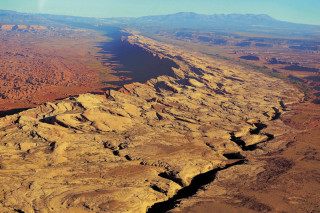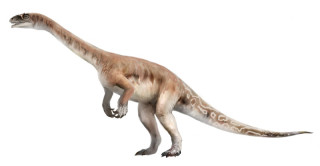Explorer Corps Marker: San Juan County
Find the Marker
The San Juan County marker is on the southeast side of the Edge of the Cedars State Park Museum at 660 W 400 N in Blanding. It highlights Comb Ridge, a 120-mile-long north to south-trending ridge from where Seitaad ruessi, the plant-eating ‘sand monster’ of Utah’s Navajo Sandstone, was discovered.
GPS 37°37’52.896”N 109°29’23.568”W
Dig Deeper
If you find yourself in the southeast corner of Utah, rolling along U.S. Highway 191 between the outpost towns of Blanding and Bluff, you’ll eventually pass through a great gap in the rock. It almost seems like a huge geologic wave of reddish rocks extending to either side, ridged pillows of whitish rock on top. This isn’t just any geologic feature, but Comb Ridge – the place of discovery for one of Utah’s rarest dinosaurs.

Comb Ridge is an intersection point for natural history. Take a four-wheel-drive vehicle along one of the sandy roads at the base of the cliffs and you’ll drive through a hot, shrubby desert. Here and there, you’ll be able to spot petroglyphs chipped into rocks by Native Americans. But this spot is also a prime hunting ground for paleontologists interested in the Late Triassic and Early Jurassic. The rocks in this area span the dividing line between the two time periods, about 201 million years ago, and have preserved forms of ancient life not seen anywhere else. One of the grandest discoveries was of a dinosaur named Seitaad ruessi.
“The dinosaur Seitaad ruessi is unique to Utah,” says Dr. Randall Irmis, NHMU's chief curator and curator of paleontology. “In fact,” he adds, “only one specimen has ever been discovered, and that was at Comb Ridge.” This Early Jurassic dinosaur is categorized as a sauropodmorph, or a member of the broad family that includes long-necked, herbivorous dinosaurs like Diplodocus. Being an early member of the group, Seitaad was smaller – about the size of a large dog – and walked on two legs rather than all fours.

Finding such a skeleton was unexpected. Seitaad was found in 2004 by local artist Joe Pachek. A team from the NHMU went out the following year to assess and excavate the find. To find any bones at all in these particular rocks was exciting. The fossils of Seitaad were entombed in the Navajo Sandstone. These rocks are the remains of ancient deserts dominated by massive sand dunes. The particular of this ancient environment meant that tracks become preserved often, but body fossils required special circumstances – only a handful of fossil bones or skeletons are known from the Navajo Sandstone.
But how could a plant-eating dinosaur like Seitaad have survived in such an arid environment during the Jurassic? “We have geologic and paleontologic evidence showing there were spring-fed pongs in and among the sand dunes,” Irmis notes, “and these water sources were permanent enough that large conifer trees grew nearby.” The habitat was a combination of very dry sand dunes and wet oases that many animals relied on to survive. Perhaps, as paleontologists continue to explore Comb Ridge, another Seitaad – or even something new – might greet them in the prehistoric red rock.
Want to Go Farther?
Valley of the Gods is just down the highway from Comb Ridge.